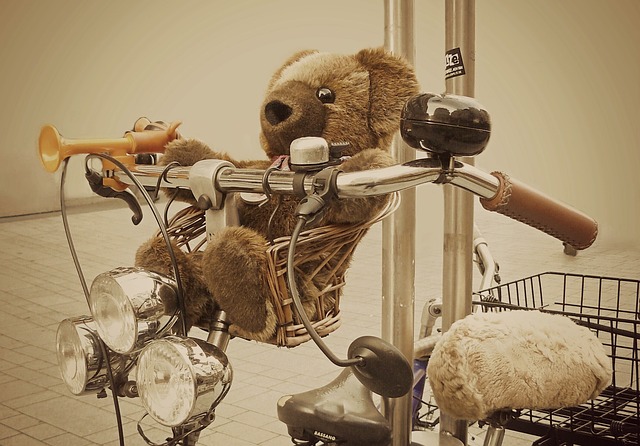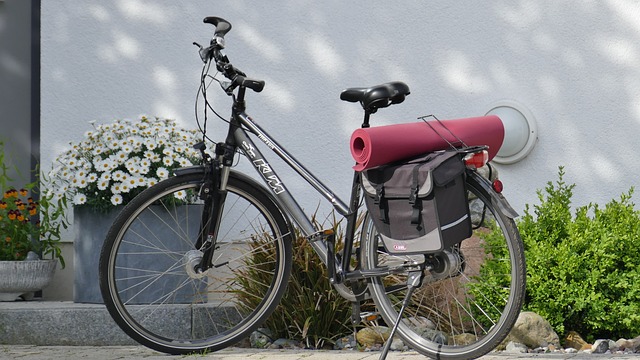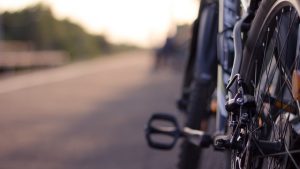Bicycle seats could be uncomfortable for many different reasons. Only the sit bones of the rider should be supported by the bicycle seat. Legs can move freely while cycling thanks to their unusual shape. An important factor in comfort is proper rider form and seat adjustment.
By knowing these causes of discomfort, you can reduce soring, allowing you to cover a few more miles.
Table of Contents
A Bike’s Discomfort
When I first began biking, I wondered why bike seats were so rigid and thin. Because they constantly gave me sores and back pains, I found them uncomfortable to sit on, especially on lengthy trips.
Then, when I eventually ran into other bikers, they explained that there are a variety of factors that contribute to the shape of bicycle seats, and that the discomfort I experienced was due to improper sizing among other things.
The only thing a biker’s seat is designed to support are their sit bones, not their entire weight. They have an unusual and slender shape that allows our lower limbs to move freely while cycling.
Additionally, while biking, your posture and the appropriate seat adjustment have a significant impact on your comfort.
Root Causes
The most frequent reasons for an uncomfortable bike seat are listed below. Knowing some can assist you in concentrating on the aspect that requires attention.
Incorrect Mountain Bike Size
Even if we have the best gears, if our bike is too big or too small for us, it can significantly alter our seating position, which is essential to our comfort.
Many people believed that mountain bike seats were created to be the most uncomfortable things in the world. They were only riding the wrong size bike, they didn’t realize.
Because of this, I strongly advise purchasing a high-quality mountain bike with the appropriate fit for you.
Started by Are Mountain Bikes Good For Commuting?
Wrong Handlebar Position
Incorrect handlebar positioning can make your bike seat sore. The wrong positioning is probably the case if you find that you lean excessively forward or backward.
This is brought on by handlebars that are too high or low, which may result in a shorter or longer reach than is necessary.
Find the best fit for you so that you can have a positive outcome.
Clothing
Comfort for your sit bones is one of the many advantages of wearing the appropriate sportswear.
Just like your bike, cycling clothing and equipment are essential. Bike seat soreness is prevented by the skin-tight, ergonomically padded PPEs that should be worn.
Bike Seat Hurts Butt
Most of you who are reading this, if not all of you, have at some point felt pain from sitting on a bike saddle. Sit bones bruises, chafing, which can irritate or harm the skin, or saddle sores, which are essentially wounds or spots, are three possible causes of this soreness.
First and foremost, not being used to a saddle frequently results in bruised sit bones, so some discomfort here is to be expected when “bedding in” a new saddle. However, to make sure the width at the back of the saddle is the closest size to your measurement, you should measure your sit bones first.
Chafing is a subsequent issue that is fairly typical and self-explanatory. It happens as a result of the saddle’s and your clothing’s materials rubbing against each other. It’s uncomfortable, but there are a few things you can use—like padded shorts and chamois cream—along with a saddle that fits your body to lessen the likelihood of chafing.
A bad thing that can happen from sitting on a saddle for a long time is skin irritation and damage. The best way to avoid this is to ride with a comfortable saddle and wear breathable clothing. If you have sensitive skin, some irritability may still happen, but sometimes you just have to let your nether regions get used to it.
Check for Is Cycling Good For Your Butt?
A Saddle, Not a Seat
It makes sense to refer to the object you sit on as a seat for a novice rider. However, the seat is actually referred to as a saddle in the cycling community. Despite what might seem to be minor semantic differences, there are significant ones.
The main distinction between a seat and a saddle is that a seat is designed to support your entire weight while a saddle is not. Where is the remainder of your weight carried if a saddle is only designed to support a portion of your weight? On the pedals, you should put most of your weight.
Understanding the crucial distinction between a seat and a saddle will greatly improve comfort. On a bike, the same things that make a typical seat comfortable are bad ideas.

Why Are Bike Seats So Small and Skinny?
When you first get a bike, you might be looking at the seat thinking, “You expect me to sit on that??”. Bicycle saddles have an odd shape, but there are good reasons for it.
Even though there have been numerous attempts to completely redesign the bike seat, none of them have significantly altered it. Although there are some shape variations and some new materials that have become mainstays, the seats are frequently still uncomfortable. So why do these rigid and slender designs still reign supreme in today’s fashion?
Contrary to popular belief, the harder, narrower seats are typically the most comfortable. Let’s take a closer look at the purpose of the seat before ruling out any wide, padded models for good.
What is comfortable to sit on whilst relaxing isn’t necessarily what’s comfortable for doing something that involves some strenuous physical exercise
While the thought of relaxing on a warm, soft leather couch while watching TV may be appealing, riding will be extremely uncomfortable due to this comfort. In actuality, the opposite of what you want is soft material that traps heat and moves whenever you press against it.
Your sit bones, also called your Ischial Tuberosity, are the most crucial point of contact on a bike seat. Your best options for maintaining your posture are these two bones. If you picture your sit bones as little pillars supporting your position on the bike, you’ll realize that they don’t move around much because they are made of bone (even if they have some padding on the outside).
You risk rubbing, overheating, and chafing as more of your butt and other body parts come into contact with the seat. Those softer parts are probably going to move and hurt more frequently. As a result, it is usually preferable to sit on the seat rather than inside it, and to do so, you need a seat that is harder.
You definitely don’t want something that just supports your sit bones because some of the pressure needs to be distributed. However, wider seats may have too much surface area and be very uncomfortable, particularly if they are soft.
Also narrow for a reason is the nose at the front of the seat. Because a wider nose frequently doesn’t provide enough room for the rider’s thighs, you might find yourself constantly rubbing against the front of the seat.
The reality is that there are many models on the market that combine support for the sit bones with a little padded softness and width. However, in order to illustrate the concept, we are comparing the extremes of very soft seats. However, it’s crucial to remember that wide, soft seats are not necessarily the most comfortable option; in fact, quite the opposite is true.
If you picture a hard gym floor and a soft gym mat, the soft mat might initially seem more inviting to sit on. However, the firm, level floor would probably be your first preference if you were performing an exercise like a plank.
Not One Size Fits All
According to public perception, the ideal saddle is one that fits everyone. Since people differ, it will never be produced. Purchasing a saddle that fits you is the true sign of wisdom.
This still holds true today. Similar to shoes, not every person will fit into the same size saddle. You might have to try a few different saddles before you find the right fit. There is no doubt that bicycle saddles come in a variety of sizes.
People would be measured for a seat in a similar manner to how they are measured for bicycles. The overwhelming majority of people are able to locate a saddle that is the ideal shape for them. Getting fitted for a bike seat at your neighborhood bike shop or dealer is not a bad idea.
Different Seats for Different Riding
There are various shapes for different types of riding on bicycle seats. The seat will typically be thinner as you ride faster. This is because as you ride faster, your legs and handlebars will be bearing more of your weight rather than the seat.
In general, racers will lean more forward and ride with their feet closer to the front of the bike. This will frequently favor a simpler, more aerodynamic seat with sharper edges.
Less aggressive riders might opt for seats with a slight curve in the design, which can relieve pressure on body parts that come into contact with the seat. A slightly wider seat is frequently more comfortable for them because they are also more inclined to sit more upright.
Different Seats for Different Terrain
Different seats are designed for various terrains, as well. Cycling enthusiasts and road cyclists alike frequently occupy stationary positions in chairs for extended periods of time. The uneven terrain for mounting bikers means that they will probably be in different positions on the bike and require both durability and a streamlined shape.
Cut-out seats are lighter and less stressful on the body because they have had the middle portion removed. Long-term pressing can harm the nerves and reduce blood flow, but cut-outs help to some extent.
Cut-outs are offered by all the major brands and can be helpful for both male and female riders. Taking a brief break every 20 to 25 minutes can be a very helpful additional step in this process. Even 20 seconds away from your seat can significantly reduce stress.
Importance of Proper Fit, Form, and Height
We’ll talk about how a lot of complaints about the bike seat may actually be due to other problems, like handlebar position. On a bike, the connections between various pressure points can be very intricate.
The bike seat is frequently the symptom but not always the cause of the problem. So, how should you get fitted for a seat given that bodies naturally come in a variety of shapes and sizes?
The sit bone distance, as previously mentioned, should be the first measurement made. Typically, people will add an extra 30 cm to this measurement to estimate where you should sit on a seat (both your body and the seat will have some give in them).
Visit your local bike shop once you are aware of your sit bone measurements and riding style. While there are many different ways you can calculate the height and adjustments for a new saddle including the K.O.P.S. method and the Holmes method, there are many variables to consider.
It’s important to experiment with different seats while riding your bike in order to feel and observe how they affect your riding position.
Weight and pressure can be redistributed to positions that could be problematic, and even small adjustments can have a significant impact on how you ride. However, if you’re doing it yourself, there are a few things to think about and watch out for.
In most cases, the seat should be horizontally level, and you can check this with a small builders level or, in a pinch, an app on your phone. There is no justification for tilting backward, which would only increase pressure in a place where you least want it. However, riders may occasionally have a slight forward incline in races because it helps engage the gluteus, a powerful muscle group.
The height and separation from bars, in addition to the level, are both extremely significant. It makes sense to classify your seat issue as a position issue if you notice yourself slipping forward on the seat.
However, the barns are frequently too far forward. Additionally, if the seat is too low, pressure that should be applied to the feet is more likely to be applied elsewhere. Without any real cause, you might notice tension in your butt, shoulders, and hips.
Finding a seat that fits your sit bones, is appropriate for your riding style, and complements your shape and positioning on your bike is the objective because each measurement of the bike affects and links to the others. The majority of the time, this entails going to a bike shop where you can ride your bike around and test out various models.
How Can I Make My Bike Seat Comfier?
Start by selecting the ideal saddle for you to give your journey a boost. Everybody’s bums are different, just like everyone’s faces, and only we can comprehend what they are. Because of this, relying on the subjective judgments of others could succeed or fail for you.
Make sure the saddle is the proper size for your butt. Select a product so that your sit bones, rather than the soft tissues around them, bear the weight of your body.
Be aware that a saddle that is too narrow or thin won’t distribute your weight evenly. On the other hand, too-wide saddles would rub against our crotch.
The Bluewind Waterproof Bicycle Saddle is renowned for its ergonomic size and design that perfectly suits the majority of bikers. Due to its high compatibility, this saddle is a good option if you’re having trouble selecting a new one.
To reduce weight, some bikers favor the lightest, firmest saddles.
The cyclist cannot train effectively if the saddle is uncomfortable. If this occurs, the fitness loss will outweigh the advantages of the saddle.
Choosing the right material is another way to a more comfortable saddle.
The most popular and well-known saddles are made of synthetic materials, which are known for being lightweight and low maintenance. They don’t require break-in time either, which is another reason why cyclists favor them.
Another material used to make saddles is cotton. This material also provides a very quick break-in time, though it is not a typical option. Cotton also has some give, giving you good control and comfort during the journey.
Leather is a respectable option if you’re searching for a synthetic cover replacement. It offers a superb fit and excellent comfort. But after 320 kilometers of cycling on leather, it needs to be broken in.
You must constantly apply conditioner to the saddle because leather is not water-resistant; doing so also helps to stop the leather from drying out as a result of UV exposure.
On the other hand, foam provides good cushioning and thus makes you feel comfortable. When you get off the bike, the foam cushion eventually returns to its original shape.
Because of this, riders who weigh more than 90 kg and people who enjoy taking long trips should use this saddle material. In addition, those with excellent sit bone health should choose this material.
Although gel cushioning is not as comfortable as foam cushioning, this material is still the best for recreational bikers who frequently take leisurely rides in the plaza. It compresses more quickly than foam saddles, which makes it less comfortable.
Along with the material, it’s crucial to think about the saddle pad, a bike accessory that adds a touch of plushness and coziness.
However, keep in mind that this accessory is not the ideal solution to your padding problems and is not suggested for long and brisk rides. However, if you ride a bike more for fun or casually, you won’t have any issues with this.
Despite the fact that I introduced a number of cushioning materials, some saddles still have none. Despite the fact that they may be uncomfortable at first, non-cushioned saddles are typically comfortable for bikers as they gradually adapt to their weight and body shape.
Saddles without any padding are actually very comfortable once you get used to them. Additionally, they keep their coolness, keeping you cool and refreshed throughout your bike trip.



